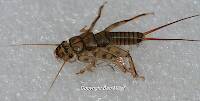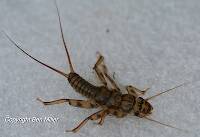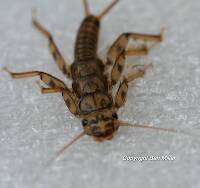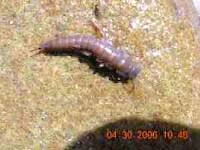
Salmonflies
Pteronarcys californica
The giant Salmonflies of the Western mountains are legendary for their proclivity to elicit consistent dry-fly action and ferocious strikes.
Featured on the forum

This one pretty clearly keys to Kogotus, but it also looks fairly different from specimens I caught in the same creek about a month later in the year. With only one species of the genus known in Washington, I'm not sure about the answer to this ID.

Troutnut is a project started in 2003 by salmonid ecologist Jason "Troutnut" Neuswanger to help anglers and
fly tyers unabashedly embrace the entomological side of the sport. Learn more about Troutnut or
support the project for an enhanced experience here.
Entoman on May 4, 2012May 4th, 2012, 7:25 pm EDT
I don't recognize the head capsule pattern off the top of my head, but it sure looks like a perlodid to me Paul, either a Springfly or Stripetail. A few answered questions might help us nail down the genus. Did it have thoracic gills? How about longitudinal abdominal striping (can be very feint). If we can get the choices down to a couple of genera, I'll look though what I've got to see if I can come up with a head match. Your specimen looks pretty distinctive.
"It's not that I find fishing so important, it's just that I find all other endeavors of Man equally unimportant... And not nearly as much fun!" Robert Traver, Anatomy of a Fisherman
PaulRoberts on May 5, 2012May 5th, 2012, 4:30 pm EDT
No striping. There were some striped (Isoperlid?) guys there. I didn't think to look at gills. If there were, they were small and not visible from the topside (only images I have). Didn't expect to post this originally.
Entoman on May 5, 2012May 5th, 2012, 11:28 pm EDT
Well, your answers don't make it as easy as hoped.:) If it had gills they would be small and finger-like or even bumps emanating from the thoracic joints behind the legs and perhaps even from the cervical joint. FWIW I'm not seeing any evidence of them in the photo, though it must be conceded that reliable determinations are much easier if the critter is held upside down for a good close-up of the thorax and head. What to look for are the presence of gills and a good look at the mouth parts and mesosternum.
Assuming a lack of gills, of the five genera lacking this character known for CO, four are represented by single species. Of these four, Cultus is too small and Diura, Arcynopteryx and Skwala look different both in pattern and conformation (wing pad shape, legs, etc.).
While the remaining genus usually has stripes, their absence is not as diagnostic as once thought and the thick narrow cervix, shape of the wingpads, and antennae length sure look right. I'm thinking Isoperla and will start looking there for a head capsule match. Hopefully one exists, though there are at least 11 species reported from CO and to my knowledge many have never been photographed.
Assuming a lack of gills, of the five genera lacking this character known for CO, four are represented by single species. Of these four, Cultus is too small and Diura, Arcynopteryx and Skwala look different both in pattern and conformation (wing pad shape, legs, etc.).
While the remaining genus usually has stripes, their absence is not as diagnostic as once thought and the thick narrow cervix, shape of the wingpads, and antennae length sure look right. I'm thinking Isoperla and will start looking there for a head capsule match. Hopefully one exists, though there are at least 11 species reported from CO and to my knowledge many have never been photographed.
"It's not that I find fishing so important, it's just that I find all other endeavors of Man equally unimportant... And not nearly as much fun!" Robert Traver, Anatomy of a Fisherman
PaulRoberts on May 6, 2012May 6th, 2012, 7:46 am EDT
I'll photo both sides next time.
Quick Reply
Related Discussions
Topic
Replies
Last Reply
1
Sep 5, 2006
by Troutnut
by Troutnut
2
Dec 26, 2019
by Millcreek
by Millcreek
0
Sep 26, 2020
by Millcreek
by Millcreek








